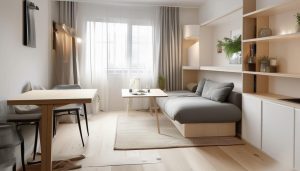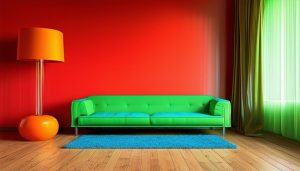Enhancing a workspace requires selecting the right desk. Consider writing desks, computer desks, and executive desks for different purposes.
Prioritize size, material, ergonomics, storage options, and design. Think about space utilization, health, and posture.
Remember regular maintenance and repairs for long-term preservation and efficiency.
Table of Contents
ToggleI. Types of Desks
Selecting a desk for your workspace involves exploring different types like computer desks, executive desks, and standing desks.
Computer desks are tailored for computer use, featuring keyboard trays and cable management systems.
Executive desks are spacious and made of high-quality materials, offering ample storage and workspace.
Standing desks have gained popularity for their health benefits, allowing users to switch between sitting and standing positions throughout the day. These desks promote better posture, reduce risks associated with prolonged sitting, and can enhance productivity.
Incorporating a standing desk into your workspace creates a dynamic and ergonomic environment that supports overall well-being. Choosing the right desk, whether for functionality, elegance, or health-conscious design, is crucial for enhancing your workspace.
A. Writing Desks
Writing desks are smaller than traditional desks and feature a simple and sleek design. They may include minimal storage options like a drawer for organization.
These desks can be crafted from materials such as wood, metal, or glass, each offering unique aesthetics and durability levels. Some writing desks may come with additional features like a keyboard tray for convenience.
Choosing a writing desk that suits your style and workspace needs can enhance comfort and productivity.
B. Computer Desks
Computer desks are designed for housing computers and related equipment, providing ample space for monitors, keyboards, and peripherals. These desks often incorporate cable management systems to keep wires organized and out of sight, ensuring a tidy workspace.
Some models offer adjustable shelves or drawers for convenient storage of office supplies. The materials used in computer desk construction vary from wood and metal to glass, allowing for various styles and finishes to match workspace aesthetics.
Additionally, ergonomic computer desks prioritize user comfort and health by offering features like adjustable heights, keyboard trays, and monitor stands to promote good posture and reduce strain. When selecting a computer desk, consider specific needs regarding storage, cable organization, and ergonomic support to enhance productivity and well-being.
C. Executive Desks
Executive desks are designed for professionals needing ample workspace with luxurious materials like solid wood and metal accents. They feature built-in storage solutions such as drawers, shelves, and cabinets.
Many executive desks come equipped with integrated technology features like wire management systems and power outlets. The design is tailored for executives and professionals, combining functionality with a sophisticated aesthetic to create a workspace that exudes power and professionalism.
D. Secretary Desks
Secretary desks are compact and versatile office furniture options for efficient workspace organization. These desks feature a hinged desktop that can be folded down to hide clutter, providing a clean workspace. With drawers and compartments for storage, secretary desks are ideal for organizing office supplies, papers, and small items, enhancing workspace functionality. Designed to save space while maintaining practicality, these desks are perfect for smaller home offices or work environments where maximizing space is essential.
The fold-down top of a secretary desk serves as a convenient writing surface or laptop stand, offering an efficient work area within a compact design. Despite their space-saving nature, these desks don't compromise on style; their classic and elegant design adds sophistication to any workspace. Secretary desks offer practical storage solutions, making them a valuable asset for enhancing productivity in any workspace.
E. Standing Desks
Standing desks are popular in modern workspaces for their health benefits and impact on productivity. Using a standing desk can reduce sedentary behavior, lowering the risk of obesity, heart disease, and diabetes. Height-adjustable standing desks allow users to switch between sitting and standing positions, promoting better posture and decreasing back pain. Studies show that standing desks can enhance energy levels, focus, and overall productivity. Additionally, they may improve mood, reduce stress, and combat feelings of fatigue.
II. Factors to Consider When Choosing a Desk
When selecting a desk for your home office, consider the available space, work requirements, and habits to optimize your workspace.
Choose a desk with ample storage options to keep your area organized. Prioritize ergonomics by selecting a desk that ensures proper alignment and comfort to prevent strain.
Consider the material and design to match your home office decor. By focusing on space, storage, and ergonomics, you can enhance productivity and comfort in your work environment.
The desk you choose will significantly impact your daily work life, so choose wisely to meet your needs effectively.
A. Size
The size of a desk significantly impacts workspace optimization. When choosing a desk, consider the surface dimensions for ample room for a computer, monitor, keyboard, and work tools.
A larger desk offers more workspace for materials and multitasking. Opt for a desk with adjustable height for ergonomic benefits. The desk size should allow comfortable movement and easy access to storage.
Selecting a desk size that fits your needs and space creates an efficient work environment that enhances productivity.
B. Material
Desk material choice significantly impacts the workspace's aesthetic and functionality. Different materials offer unique benefits:
- Wood Desks: Known for their timeless appeal and durability, wood desks provide a classic and elegant look to the workspace.
- Metal Desks: Sturdy and long-lasting, metal desks are ideal for heavy use and industrial settings, offering a modern and sleek aesthetic.
- Glass Desks: Glass desks create a contemporary and stylish vibe by reflecting light, brightening the space and adding sophistication to modern and minimalist designs.
- Laminate Desks: Cost-effective and easy to maintain, laminate desks offer versatility and functionality with a wide range of colors and finishes to match various decor styles.
C. Design
Enhance your workspace by selecting furniture and decor that reflect personal style and boost productivity. Prioritize ergonomic features and efficient organization in desk design. Choose a desk with adjustable height settings and proper lumbar support to reduce discomfort and injury risk. Opt for a clutter-free workspace with built-in storage solutions or organizers like drawers, trays, or cable management systems to maintain focus and productivity.
Incorporate elements like plants, artwork, or inspirational quotes to create a positive and motivating environment. Select a color scheme based on psychological research to promote focus and creativity. Choose colors that resonate with you to stay engaged and inspired throughout the workday.
D. Storage Options
Implementing efficient storage solutions can enhance document organization and accessibility in a workspace. Consider investing in filing cabinets and shelves for optimal storage options.
Filing cabinets are perfect for storing important documents, contracts, and reference materials in a systematic manner.
Shelves can be used to store office supplies, books, and decorative items, categorized and labeled with organizers and dividers for quick retrieval.
Designated spaces for office supplies, a chair, and a lamp help maintain a tidy workspace. Arrange storage units for easy location and retrieval of items, saving time and reducing stress during work hours.
E. Ergonomics
Optimizing comfort and productivity in workspace design requires adherence to ergonomic principles.
When setting up a computer workstation, consider these key elements:
- Select an adjustable chair supporting lower back and feet flat on the floor.
- Position the monitor at eye level to reduce neck strain.
- Keep the keyboard and mouse at a comfortable height for arms.
- Maintain proper spinal alignment by sitting upright with back against the chair.
III. The Role of Desks in Home Office Setup
Desks are essential for creating a productive and organized home office space. They serve as a central work hub, enhancing focus and efficiency.
To optimize your home office setup, consider the following key points:
- Size and Shape: Choose a desk with dimensions that fit well in your space and provide ample room for work tasks.
- Storage Features: Opt for desks with built-in storage like drawers and shelves to keep your workspace organized and clutter-free.
- Standing Option: Consider a desk that offers the flexibility to switch between sitting and standing, promoting movement and improving health and posture.
- Cable Management: Look for desks with effective cable management systems to maintain a neat and professional workspace conducive to productivity.
A. Space Utilization
Efficient workspace utilization requires careful consideration of desk dimensions, storage capacity, placement, and material.
Choose a desk that fits well in the workspace, offers sufficient storage, and enhances the room's aesthetic with wood, metal, or glass material options.
Position the desk strategically for proper lighting, easy access to power outlets, and minimal distractions.
Select a desk shape – L-shaped, corner, or rectangular – that complements the overall workspace design and workflow.
B. Productivity Enhancement
Ergonomic desks are designed to promote proper body alignment and posture, reducing the risk of musculoskeletal disorders.
To increase productivity in the workspace, consider the following tips:
- Standing desks can boost productivity and energy levels while decreasing sedentary behavior.
- Adjustable desks allow for seamless transitions between sitting and standing positions, enhancing comfort and focus throughout the day.
- Built-in cable management systems help maintain a tidy workspace, improving organization and efficiency.
- Customizing the desk height to your individual stature can prevent strain and discomfort, ultimately enhancing productivity and well-being.
C. Comfort and Health Considerations
Utilizing an ergonomic chair with lumbar support and adjustable features can reduce back pain and enhance posture.
Opting for a height-adjustable desk promotes movement and decreases the likelihood of musculoskeletal issues.
Monitor risers and document holders prevent neck strain and increase comfort during work hours.
Task lighting reduces eye strain, enhances visibility, and fosters a productive environment.
Ergonomic keyboard trays and adjustable monitor arms allow for a customized setup that optimizes comfort and efficiency.
Incorporating these considerations into your workspace supports physical well-being and productivity.
IV. The Evolution of Desks
Desks have evolved significantly, transitioning from basic tables to advanced ergonomic workstations designed for comfort and productivity. Today's desks combine functionality, style, and technology integration to meet diverse work needs. The evolution of desks can be summarized as follows:
Ancient desks like the 'bureau' showcased intricate designs and storage compartments, emphasizing craftsmanship and organization.
Modern desks offer adjustable features like height settings and ergonomic accessories to customize workstations for comfort and efficiency.
Standing desks have become popular for promoting movement and reducing sedentary behavior, contributing to better health and productivity.
The focus on individual needs is evident in the shift towards ergonomic designs and customizable options in modern workspaces.
A. Historical Background
Throughout history, desks have evolved to meet changing societal needs and design preferences. Ancient Egyptians used stone slabs as desks, while the Renaissance period saw ornate writing desks. The Industrial Revolution popularized the roll-top desk for its storage capabilities. In the 20th century, modular desks became prominent for flexibility and efficiency.
These historical shifts laid the foundation for modern desks like standing desks for health benefits, adjustable desks for ergonomic support, and compact desks for space optimization. Contemporary desk designs focus on minimalist styles, eco-friendly materials, and technological integrations like charging stations and cable management systems to meet digital age workspace requirements.
B. Modern Developments
Desk design advancements focus on enhancing functionality and comfort to meet changing needs. Key developments shaping workspaces include Adjustable Height Desks that promote ergonomic posture, reducing musculoskeletal issues.
Standing Desks, gaining popularity, offer health benefits like reducing sedentary behavior and improving circulation. Sit-Stand Desk Converters provide flexibility, allowing users to switch between sitting and standing positions easily.
Some desks feature Built-In Cable Management Systems to keep wires organized and out of sight, enhancing workspace aesthetics and reducing clutter and distractions.
C. Future Trends
The future of workspace furniture is moving towards innovative designs integrating smart technology for enhanced functionality and comfort. Smart desks with features like wireless charging and adjustable settings for ideal ergonomics are gaining popularity.
Standing desks are also on the rise, promoting better posture and increased energy levels as a preventive measure against sedentary lifestyles. Sustainable materials such as bamboo and recycled plastics are becoming more prevalent in workspaces.
Collaborative desk designs, like shared workstations and modular setups, are expected to facilitate teamwork and communication in office environments. The potential integration of virtual reality into desk design is a future trend that could offer immersive work experiences and customizable virtual workstations to boost productivity and creativity.
These trends are shaping the future of workspace furniture towards more efficient, sustainable, and technologically advanced options for enhancing work environments.
V. How to Maintain and Care for Your Desk
Maintenance Tips for Desk Care
- Regular Cleaning:
Clean your desk surface regularly with a mild cleaner to remove dust and germs, promoting a healthy workspace.
- Prevent Damage:
Avoid placing heavy or sharp objects directly on the desk surface to prevent scratches. Use protective pads or mats for added protection.
- Use Coasters and Pads:
Always use coasters or pads under drinks and hot items to prevent stains and heat damage.
- Organize Accessories:
Dust and wipe down desk accessories and equipment regularly for a clutter-free workspace. Utilize desk organizers and storage solutions for enhanced productivity and organization.
A. Cleaning Techniques
Regularly dusting and wiping desks with a microfiber cloth effectively removes dirt and germs, maintaining a clean workspace. Using a mild cleaner or disinfectant is important, especially for shared desks.
Desk organizers and trays can help declutter and prevent dirt buildup. Vacuuming or sweeping around the desk area regularly keeps it free of dust and debris.
Consider implementing a weekly or monthly deep cleaning routine for thorough maintenance. These practices create a productive workspace that promotes focus and well-being.
B. Repair and Restoration
To repair and restore a desk, start by identifying damage like scratches, dents, or discoloration.
Sand the surface to remove imperfections. Apply wood filler to damaged areas for a seamless look. Refinish the desk with paint or stain.
Repair structural issues like loose joints or broken parts using woodworking skills or professional assistance for stability and functionality.
C. Long-term Preservation
Regular cleaning with a mild detergent and a soft cloth can prevent dirt and stains on your desk.
Avoid placing heavy or sharp objects directly on the desk to prevent scratches, dents, or damage.
Applying a protective coating or sealant can provide extra defense against wear and tear, preserving the desk's condition.
Follow manufacturer's guidelines for cleaning and maintenance to safeguard the desk's longevity and durability.
VI. The Environmental Impact of Desk Production
Understanding the environmental impact of desk production is crucial when choosing workspace furniture. The demand for desks leads to deforestation, with millions of trees cut down annually. Additionally, the energy-intensive processes involved in desk production result in significant carbon emissions.
Harmful chemicals and adhesives in desk materials like particleboard and MDF release volatile organic compounds (VOCs) into the environment. Moreover, the transportation of desks from factories to retailers or consumers contributes to fuel consumption and greenhouse gas emissions.
A. Material Sourcing
Enhancing workplace sustainability involves mindful material selection. Evaluating eco-friendly options like reclaimed wood or bamboo is essential. Reclaimed wood adds history and character while reducing the demand for new timber. Bamboo, known for rapid growth and renewability, offers a durable and stylish alternative.
Steel desks are durable and modern, ideal for industrial or contemporary settings. Solid wood desks exude timeless elegance and warmth, perfect for traditional or rustic environments. Glass desks create a minimalist look suitable for modern design preferences or small spaces. Laminate desks offer cost-effective solutions with various finishes for versatility and easy maintenance.
Consider these material options to align your desk choice with your workspace needs and sustainability goals.
B. Manufacturing Process
Desk manufacturing involves cutting, shaping, and assembling wood, metal, or composite materials.
Key points include the use of precision machinery like CNC routers and laser cutters for accurate dimensions. Quality control measures such as sanding and painting are essential for durability.
Sustainable practices with eco-friendly materials are becoming increasingly important in the industry. Collaboration with designers, engineers, and craftsmen is crucial for creating innovative desk designs.
C. Disposal and Recycling
Proper disposal and recycling of old office equipment, including computers, printers, and other electronic devices, are essential for environmental sustainability. Recycling centers offer services to handle electronic items safely, managing hazardous materials correctly.
VII. Conclusion: The Importance of Choosing the Right Desk
When selecting a desk for your workspace, consider factors like size, material, design, and storage options. The right desk can enhance productivity and comfort by providing adequate workspace and ergonomic support.
A well-chosen desk can contribute to a clutter-free and organized workspace, promoting focus and creativity. Investing in a quality desk that aligns with your preferences can have long-term benefits for your work environment.
Size, material, design, and storage options play a significant role in your daily work routine and well-being. Ensure the desk fits your workspace and allows for comfortable movement. Choose a durable material that complements your workspace aesthetics.
Select a design that aligns with your work habits for excellent functionality. Look for desks with adequate storage to keep your workspace organized and efficient.





